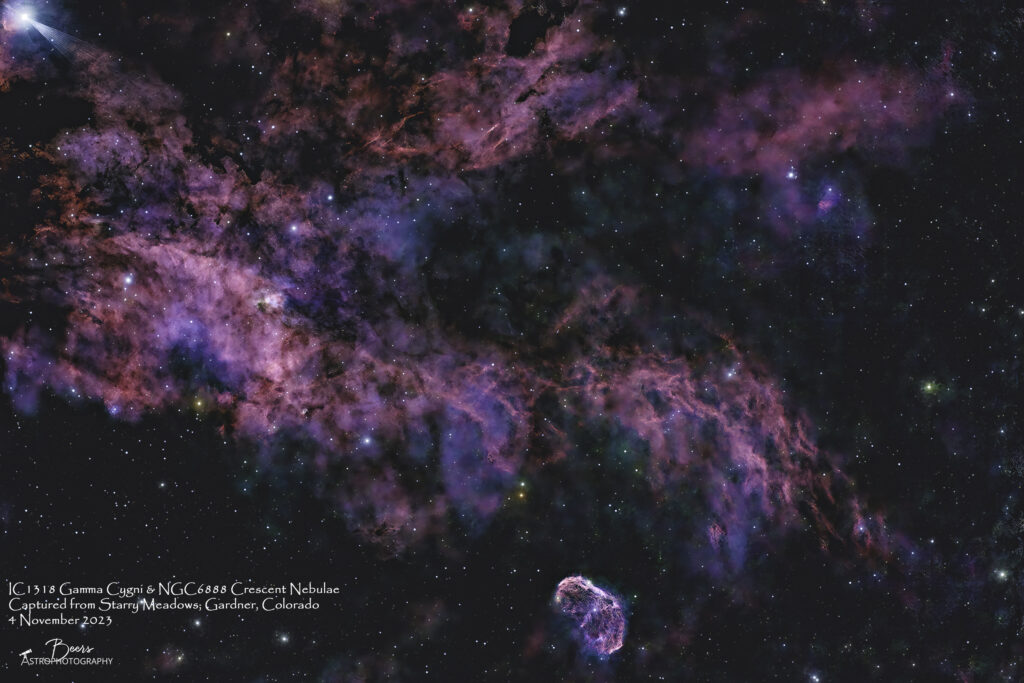
Fun facts
Target Fun Facts: Part 1: Gamma Cygni Nebula, also known as the Sadr Region or IC 1318, is a very large diffuse emission nebula that can be seen around Sadr (Gamma Cygni), the star at the center of the Northern Cross, which marks the heart of Cygnus, the Swan. Despite the name, the star and the nebula are unrelated. Even though it looks embedded in the nebulosity, Sadr is approximately 1,800 light years distant, while the nebula is much further away, at 4,900 light years.
The Gamma Cygni Nebula is considered an emission nebula because it is ionized by the radiation of the nearby stars and it emits visible light as a result. The visible portion of the HII region stretches over an area more than 100 light years across. (This is why there are so many images designated as IC1318 Gamma Cygni (including those on this website at: https://beersastrophotography.com/gallery/ic1318-gamma-cygni-nebula-butterfly-nebula/) that look so completely different). The nebula is illuminated by an O9-class star which is visually obscured by interstellar material.
Sadr is one of the bright stars of the Northern Cross and it marks the heart of the celestial Swan. It is a white supergiant star with an apparent magnitude of 2.23. With 12 solar masses and 150 times the Sun’s radius, the star is about 33,000 times more luminous than the Sun.
The Gamma Cygni Nebula has three distinct parts, designated as IC 1318 A, B and C. The dark cloud about 20 light years thick that divides IC 1318 B and C is a dark nebula known as LDN 889. It is physically related to the emission nebula and the surrounding molecular cloud complex. The dark dust lane is responsible for the nebula’s distinctive shape, resembling that of a butterfly, which is why IC 1318 is sometimes also known as the Butterfly Nebula. The components IC 1318 B and C are not separate parts of the nebula, but a single cloud visually separated by LDN 889. IC 1318 is not to be confused with the Butterfly Nebula (NGC 6302), a bipolar planetary nebula located in the constellation Scorpius, the bright planetary Butterfly Nebula (NGC 2346) in Monoceros constellation, or the planetary nebula known as Minkowski’s Butterfly (M2-9) or the Twin Jet Nebula located in Ophiuchus.
Distance: 4900 light years (Constellation Guide), 815.5 light years (Stellarium)
Type: Emission Nebula (Constellation Guide) HII region (Stellarium)
Apparent dimensions: 1°50’ x 1°
Constellation: Cygnus
Designations: Gamma Cygni Nebula, IC1318, LBN245, Ced176c; Sadr Region, SH2-108, LBN234
{From https://www.constellation-guide.com/gamma-cygni-nebula-sadr-region/ and Stellarium}
Target Fun Facts: Part 2: Crescent Nebula (also known as NGC 6888, Caldwell 27, Sharpless 105) is an emission nebula in the constellation Cygnus, about 5000 light-years away from Earth. It was discovered by William Herschel in 1792. It is formed by the fast stellar wind from the Wolf-Rayet star WR 136 (HD 192163) colliding with and energizing the slower moving wind ejected by the star when it became a red giant around 250,000 to 400,000 years ago. The result of the collision is a shell and two shock waves, one moving outward and one moving inward. The inward moving shock wave heats the stellar wind to X-ray-emitting temperatures.
NGC6888 Crescent Nebula is a rather small object located about 2 degrees SW of Sadr. While considered bright by astronomical imaging standards, visually it is relatively faint. For most telescopes it requires a UHC or OIII filter to see. Under favorable circumstances a telescope as small as 8 cm (with filter) can see its nebulosity. Larger telescopes (20 cm or more) reveal the crescent or a Euro sign shape which makes some call it the “Euro sign nebula”.
Distance: 4700 light years
Type: Emission Nebula
Apparent dimensions: 20’x10’
Constellation: Cygnus
Designations: Crescent Nebula, NGC6888, C27, SH2-105, LBN204, Ced179, DWB19
{From https://en.wikipedia.org/wiki/Crescent_Nebula and Stellarium}
Capture & Processing Notes
This image was captured during a one-night trip to CSASTRO’s Starry Meadows property near Gardner, Colorado. It was the first target of the night because the Cygnus constellation at this time of the year is rising early in the day and setting shortly after midnight. By nightfall, when I could start the imaging (~1900MDT), it was already past the meridian so the collection went flawlessly. I cut it short (ending at 2235MDT) to have more time to spend on the night’s second target, NGC1909 Witch Head.
- Sequence plan: Gain: 158, Temp: -0°C, offset=30; 40x5min; Total exposure time: 3:20hrs.
- Captured: 4 November 2023 (4Nov2023, 1907 – 2235 MDT)
- Shooting location: Starry Meadows, Gardner, Colorado
Processing summary: Captured with SGP. Stacked in APP. Star removal with Starnet++. Processed in LR/PS
Equipment
All equipment controlled by HP Probook (DSO CTRL 1) Windows 10 laptop running Sequence Generator Pro v3.2.0.660.
- Polar alignment: QHYCCD camera (controlled by Polemaster for polar alignment)
- Imaging: (Southern Cross) Askar FRA600 on Rainbow Astro RC-135E, ZWO ASI2400MC#1 camera
- Mount: Rainbow Astro RC-135E (controlled by iHubo ASCOM driver)
- Autoguiding: Orion 60mm Multi-Use Guide Scope with Orion StarShoot AutoGuider Pro Mono Astrophotography Camera (controlled by PHD2)
